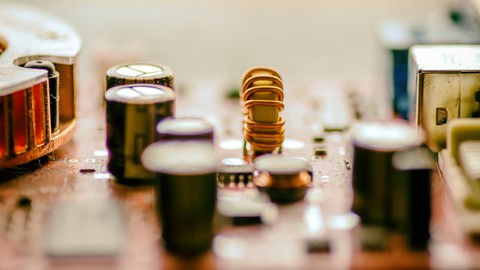
Introduction to Electronic Components: A Step By Step Guide
-
Understand the concepts of voltage, resistance and current -
Understand the VOLT OHM Meter/ Digital Multi Meter and how to use safely -
Use Ohm’s Law to calculate voltage, current and resistance -
Use resistors in various configurations -
Understand and use capacitors -
Understand and use diodes -
Understand and use a transistor
- A multimeter
- A breadboard, jumper wires and a battery
- Resistors, capacitors, LEDs, diodes, transistors, voltage regulators
>>> This Introduction to Electronic Components course is intended for those interested in learning electronics. <<<
35 Lecture | 3.5 Hour of HD Content | 2 Hour of Practical Videos | 4200 Students
>>> Continues Updates <<<
4 Star | More Than 4200 STUDENTS!!! THANK YOU!!!
What students are saying:
- André stenberg says, “This is a nice introduction course to those who would like to learn the basics of electronics.”
- Mike Mackley says, “It’s covering the topic and establishing the basics very well.”
- Sunil Thakur says, “Great course for beginning in electronics, especially enjoyed the water analogy part to make learning easier.”
- Qays Qaysaneah says, “Clear and Simple, and that is so nice :)”
Welcome to this course.
Topics that we will be discussed during the Introduction to Electronic Components Course are listed here in a brief outline.
- The Components of Electricity
- Volt-Ohm-Meter Basics (Measuring Electricity)
- Circuit Diagrams Basics (Electronic Roadmaps)
- The Resistor
- Ohm’s Law
- The Capacitor
- The Inductor
- The Diode
- The Transistor (Electronic Valves)
Things You Should Know before we start
- The topics up to and including Ohm’s Law are what we will start with.
- The remaining topics cover additional fundamental components of basic electronics.
- The course will be in platform discussion, guide practices, and open question format as the material dictates.
- The course uses a standardized volt-ohm-meter (VOM) for illustration.
Quick Summary of things that we will discuss through this course
- In this Introduction to Electronic Components Course, We will begin by discussing the three components that make up electricity.
- Next will spend more extensive time on how to measure the three components of electricity. During this section, we will explore two of the three components (voltage and current).
- This section will cover VOM basics and allow you to become familiar with the most important and most basic piece of test equipment.
- At the next section, Circuit diagrams section, you will learn how to use electronic components symbols on an electronic road map called a schematic or circuit diagram.
- Many of the symbols will represent new concepts for many of you and these concepts will be fully developed once we finish the section.
- As a result, you will develop the fundamentals of interpreting circuit diagrams so that these illustrations of the arrangement of electronic components can help you with the remainder of the course.
- The final of the three components, resistors will be covered next.
- How the three component are related mathematically is Ohm’s Law and this fundamental law will be covered in detail. These sections make up the basic, basic material of electronics.
- Four additional components common to virtually all electronic circuits are the capacitor, inductor, diode, and transistor. I will cover these topics with a level of detail that will familiarize the audience with the function of these components and the basics of how they work and react in different situations.
- There are text reading assignments for each section of the course.
- Anyone with a need to brush up their knowledge of basic electronics



